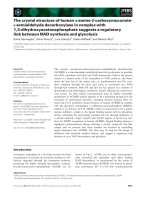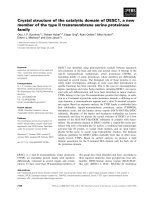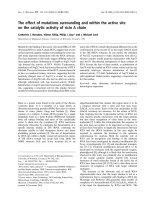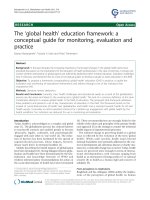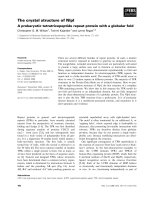the behavioral genetics of psychopathology a clinical guide - kerry l. jang
Bạn đang xem bản rút gọn của tài liệu. Xem và tải ngay bản đầy đủ của tài liệu tại đây (11.74 MB, 224 trang )
The
Behavioral Genetics
of
Psychopathology
A
Clinical Guide
This page intentionally left blank
The
Behavioral Genetics
of
Psychopathology
A
Clinical Guide
Kerry
L.
Jang
University
of
British Columbia
LAWRENCE
ERLBAUM ASSOCIATES, PUBLISHERS
2005 Mahwah,
New
Jersey
London
Copyright
©
2005
by
Lawrence Erlbaum Associates, Inc.
All
rights reserved.
No
part
of
this book
may be
reproduced
in any
form,
by
photostat, microform, retrieval system,
or any
other
means, without prior written permission
of the
publisher.
Lawrence
Erlbaum Associates, Inc., Publishers
10
Industrial Avenue
Mahwah,
New
Jersey 07430
www.erlbaum.com
Cover design
by
Kathryn Houghtaling
Lacey
Library
of
Congress Cataloging-in-Publication Data
Jang,
Kerry
L.
(Kerry
Leslie), 1962-
The
behavioral genetics
of
psychopathology
: a
clinical guide
/
Kerry
L.
Jang,
p. cm:
Includes bibliographical references
and
index.
ISBN
0-8058-4326-4 (alk. paper)
ISBN
0-8058-5358-8 (pbk.)
1.
Mental illness—Genetic aspects.
2.
Behavior genetics.
I.
Title.
RC455.4.G4J36
2005
616.89'042—dc22
2004042271
CIP
Books
published
by
Lawrence Erlbaum Associates
are
printed
on
acid-free
paper,
and
their bindings
are
chosen
for
strength
and
durability.
Printed
in the
United States
of
America
10
987654321
Contents
Acknowledgments
Preface
PART
I:
BEHAVIORAL GENETIC BASICS
Chapter
1
Introduction
Chapter
2 The
ABCs
of
Behavioral Genetics
Chapter
3
Classification
and
Diagnosis
PART
II: THE
BEHAVIORAL GENETICS
OF
THE
COMMON
MENTAL DISORDERS
Chapter
4 The
Mood Disorders
Chapter
5 The
Personality Disorders
Chapter
6 The
Anxiety Disorders
Chapter
7
Substance
Use
Problems
vii
ix
3
15
44
67
87
111
132
V
vi
CONTENTS
Chapter
8
Schizophrenia
and the
Psychotic Disorders
150
Chapter
9
Recapitulation
165
Further
Reading
172
References
174
Author Index
195
Subject
Index
205
Acknowledgments
Many
of the
ideas expressed
in
this book have been shaped
by the
work
of
many
friends
and
collaborators over
the
years, particularly John Livesley, Steven Taylor,
and
Murray Stein,
and I
thank them
all for
sharing.
I am
sure they will tell
me
that
I
have
misrepresented
or
misunderstood them
after
reading this
book,
but
that will
give
us
another excuse
to
meet, drink beer,
and
talk about
it.
Special
thanks
go to
Roseann Larstone,
my
long-suffering
assistant
who has
helped
me
from
the
outset
of
this project
to
keep track
of the
many
drafts
that
I
reg-
ularly
misplaced
as
well
as to
edit, type,
and
retype
the
ones
I
found.
Her
language
during this time
was of a
form
and
style that would make
a
longshoreman
proud.
Many
thanks
to Dr.
Bonnie Wiese,
who
bravely read
the first
draft
and
provided
in-
valuable
comments
on
what busy clinicians might care
to
read about, which helped
shape
the
content
of the
book.
Finally,
a
very
large
thank
you to all the
career-preparation students
from
Windermere,
Sir
David Thompson, John Oliver, Lord Templeton,
Sir
Charles
Tupper,
and
Lord
Byng
secondary schools (Vancouver School District)
for
their
diligence
in
checking
and
correcting references.
I
hope
the
experience
has not de-
terred them
from
a
career
in
research.
This
book
was
supported,
in
part,
by a New
Emerging team Grant (PTS-63186)
from the
Canadian Institute
of
Health Research, Institute
of
Neurosciences,
Mental
Health
and
Addiction.
vii
This page intentionally left blank
Preface
Nurture
depends
on
genes
and
genes
need
nurture.
—Ridley
(2003)
This book explores
the
theories, etiology, measurement, diagnosis,
and
treatment
of
psychopathology
from
the
perspective
of
behavioral
genetics,
a field of
enquiry
broadly concerned with
the
inheritance
of
emotional
and
behavioral patterns.
Why do
clinicians need
to
know about
the new findings
being reported every
day
by
behavioral geneticists?
The aim of
treatment
is
always
to
change emotional
and
behavioral patterns.
An
understanding
of the
genetic
influences
that contribute
to
behavioral
variability
and
change helps practitioners
and
patients plan realistic
goals
and
develop
effective
strategies
to
reach them.
For
many people,
the
term
be-
havioral
genetics
conjures
up
images
of
busy automated laboratories searching
for
susceptibility genes,
a job
known
as
genomics.
With
the
mapping
of the
human
ge-
nome, there
is no
doubt that genomics will continue
to be a
large part
of
what
be-
havioral
geneticists
do.
However, identifying
the
susceptibility genes
is
only
one
effort.
The
real impact
of
behavioral genetics lies with studies that estimate
the ef-
fect
of
identified
or
hitherto unidentified genes
on
behavior,
a
task that
has
been
la-
beled
behavioral
genomics
(Plomin
&
Crabbe, 2000). This book addresses
the
impact
of
behavioral genomics
on how
psychopathology
is
conceptualized
and ap-
proached
in our
daily work.
This book
is not
just about genetics.
In
February 2001
it was
announced that
the
human genome contains 30,000 genes, rather than
the
100,000 originally expected.
This
startling revision
led
some
to
conclude that there
are
simply
not
enough genes
to
account
for all the
different
ways people behave
and
that
behavior must also
be
ix
X
PREFACE
shaped
by
environmental
factors.
Behavioral geneticists
are
just
as
concerned with
the
influence
of the
environment
and its
interplay with genetic
factors.
This book
will
try to
spend
as
much time examining
the
role
of
experience
as
biological
factors
on the
development
of
mental illness.
Inevitably,
books
on
genetics have
to log
recent findings
in the
field.
How-
ever,
it is not my
intent
to
simply list results outlining what
is
genetic
and
what
is
not,
but
rather
to try to
answer
the
question,
"What
does knowing
the
relative
influence
of
genes
and the
environment mean
at a
psychological level
of
analy-
sis?"
What
does
this mean? This
is
best answered with
an
example.
It has
been
ar-
gued that diagnostic systems like
the
Diagnostic
and
Statistical Manual
of
Mental
Disorders
IV
(American Psychiatric Association, 1994) produce reliable diagno-
ses
of
questionable validity, because
the
system depends
on
symptom counts
to
make
a
diagnosis with little
or no
mention
of the
underlying causes
of
disease
(Helmuth, 2003). Behavioral genetics sheds light
on
these causes,
and
with
a
clearer vision
of
causes
we can
investigate
the
validity
of
current diagnoses,
or
develop
new
diagnostic entities based
on the
degree
to
which symptoms share
a
common genetic basis.
This book
is
divided
into
nine chapters.
The first
chapter delineates what behav-
ioral genetics
is and
what
it is
not,
and the
criticisms leveled
at the field.
This chapter
also introduces some ideas
on how a
biologically based genetic psychopathology
is
approached with psychotherapy. Chapter
2 is
devoted
to
methods.
It
describes
in
basic
terms
how
genetic
and
environmental
effects
are
estimated
and the
principal
methods
used
to
identify
susceptibility genes. Chapter
3 is
devoted
to
diagnosis.
This chapter shows
how
behavioral genetic research challenges
the
fundamental
ideas
underlying current nosological
and
classificatory
systems
and
describes some
directions
for how
they might
be
revised
in the
future.
Chapters
4
through
8
review
the
most common classes
of
adult psycho-
pathology. Each
is a
selective survey
of
the
published research
in the
past decade that
provides
a
sense
of
what
has
been studied
(as not all
forms
of
psychopathology have
come
under
the
behavioral genetic microscope)
and how
consistent
the findings
have been. Each highlights
one
theme that
is
important
in an
evolving comprehen-
sive
theory
of the
linkages among genetic
influences,
environmental
factors,
and
psychopathology.
Chapter
4, on
mood
disorders, introduces
the
idea
of
differential
heritability—
that psychopathology does
not
necessarily exist
as a
monolithic
and
genetically
ho-
mogeneous entity,
but
rather that each symptom
is
influenced
to
differing
degrees
by a
multitude
of
genetic
and
environmental
factors.
Chapter
5, on the
personality
disorders, presents
the
dimensional model
of
psychopathology
in
which illness
is
conceptualized
as the
extremes
of
normal function,
and
illustrates
how
behavioral
genetics
has
been used
to
test
the
validity
of
this model.
Of
all the
psychopathologies discussed
in
this
book,
the
anxiety disorders have
been shown
to be
influenced
by the
greatest variety
of
nonheritable
effects.
Chapter
PREFACE
xi
6
demonstrates
the
importance
of the
environment,
specifically,
the
mechanisms
by
which
the
environment (e.g., learning)
influence
the
development
of
disorder.
Chapter
7, on
substance use, examines
the
direct
and
indirect roles
of
genetic
and
environmental
effects
in
alcohol, tobacco, nicotine,
and
illicit
drug
use and the
rela-
tionship between these substances
to
explain polysubstance use. Chapter
8, on
psy-
chotic
disorders,
traces
the
ways
in
which
behavioral genetic research
has
provided
support
for the
neurodevelopmental model
of
schizophrenia.
The
final
chapter
of
this book recapitulates
the
main
findings
and
also draws
at-
tention
to new
threats
to
research
efforts.
I
hope that this book helps
all
readers
to
make
sense
of
behavioral genetics,
and to
integrate genetical thinking into daily
work,
and
that
it
provides
a
much
more
informed
perspective
on
mental disorders.
This page intentionally left blank
I
Behavioral
Genetic
Basics
This page intentionally left blank
Chapter
Introduction
1
Brain
and
nervous
system
disorders
may
cost
the
United
States
as
much
as
$1.2
trillion
annually,
and
affect
many millions
of
Americans
each
year.
Twin
data
suggest
that
more
than
40%
of
the
societal
burden
of
brain
disorders
is
likely
to be
genetically
mediated.
Most
of
this
disease
burden
arises
from
complex
multigene
genetics
as
well
as
from
environmental
influences.
The
large
sizes
of
these
complex
genetic
burdens
should
encourage
careful
molecular
and
clinical
work
to
link
dis-
ease
vulnerability
variants with
prevention,
diagnostics,
and
therapeutics.
—Uhl
and
Grow
(2004,
p.
223)
At
first
glance, research
in
behavioral genetics appears
to be
irrelevant
to
clinical
practice.
Rarely
do
articles comparing
the
efficacy
of
different
psychotherapeutic
approaches
make
reference
to
findings
in
genetics.
By the
same token,
few
behav-
ioral
genetic research reports discuss
the
clinical implications
of
their
findings.
The
independence
of
science
and
practice
was
noted
by
McClearn, Plomin,
Gora-Maslak,
and
Crabbe (1991),
who
wrote
that,
despite
the
fact
that many
be-
havioral
geneticists have
a
background
in the
social sciences, genetic perspectives
on
behavior have "
not yet
completely woven
into
the
pattern
of
psychological
theory
" (p.
222).
An
important purpose
of
this book
is to
begin
the
integration
of
genetics
into
clinical
thinking
and
research.
It is
often
thought that
the
only clinical application
of
genetic research
is the
development
of
drug therapies
to
counteract
the
offending
gene's
product.
The first
major step
in
this
process
is to
determine
if the
genes
hy-
pothesized
to be
associated with
a
disorder
are
actually present
in
patients with
that
disorder. Once
a
gene
is
linked
to a
specific
disorder,
the
biochemistry associated
with
the
gene becomes
the
focus
to
determine
the
intracellular mechanisms
by
3
4 1.
INTRODUCTION
which abnormal behavior
is
produced. Many researchers
in
behavioral genetics
are
trained
in
medical genetics
and
other medical specialties. Their approach
is to
work
from
the
bottom
up:
They take
the
fundamental unit
of
analysis
to be the
gene
and
its
variants. Frustratingly, successes have
been
few and far
between.
All
is not
lost, because
a
great deal
of
what behavioral geneticists
do is to
study
the
effects
of
these
as-yet-to-be
identified genes. They take
a top
down approach that
be-
gins
with recognized disorders (e.g.,
the
symptoms
and
signs
of
mental illness)
and
uses
genetically informative samples, such
as
twins
or
adoptees,
to
determine
if
indi-
vidual
differences
in the
disorder
are due to
genetic variations
or to
changes
in
envi-
ronmental conditions. Genetic
effects
refer
to the
influence
genes
have
on the
development
of
individual
differences
in
behavior relative
to the
influences
of
learn-
ing,
experience,
and
environmental conditions.
The
size
of
genetic
and
environmen-
tal
effects
can be
estimated
for a
single
disorder
such
as
major
depression
or for
individual symptoms like sadness
or
insomnia.
We can
estimate
the
relative genetic
and
environmental impact
on
virtually
any
behavior that
can be
measured reliably.
This introductory chapter will explain some important basic concepts, such
as the
definition
of
illness, outline some
of the
criticisms leveled
at
behavioral genetic
re-
search,
and finally
describe some psychotherapeutic approaches being developed
to
address behavior whose expression
may be fixed by
inherited
factors.
GENETIC EFFECTS
One of the
best-known indices
of
genetic
effect
is the
heritability
coefficient,
sym-
bolized
by the
term
h
2
.
This statistic indexes
the
proportion
of the
observable dif-
ferences
measured within
a
sample
of
people that
are
directly attributable
to the
genetic
differences
between them. Genetic
effects
are
often
converted
and ex-
pressed
as
percentages.
For
example,
h
2
- 40%
means
that
40%
of
the
differences
observed between people
are
directly attributable
to
genetic
differences
between
them.
A
popular method
to
estimate
h
2
is to
measure
the
similarities (e.g., using
the
simple correlation
coefficient)
of
infants
who
were adopted
and
raised
by
bio-
logically
unrelated
families
to
their biological
family
members
after
they have
reached adulthood.
Any
similarities between
the
adopted children
and
their bio-
logical
relatives
can
only
be due to the
genes they share, yielding
an
estimate
of h
2
.
It
follows
that
if
h
2
=
40%,
then
60%
of
the
differences
between people must
be due
to
environmental
factors,
including
the
influence
of
family
environment. Family
environmental
effects,
symbolized
as c
2
, can be
estimated
by
comparing
the
simi-
larity
of
adopted children
to
their adoptive
families.
Because
they have
no
genes
in
common,
any
similarity
can
only
be due to the
fact
that they
all
share
the
same
home environment.
Few
disorders
are
entirely under genetic control. Even
if a
disorder were 100%
heritable,
the
expression
of the
relevant genes might still
be
controlled
by
environ-
mental
factors
such
as
learning experiences
or
exposure
to a
specific
environmental
condition.
There
are
many examples
of
this
phenomenon
in the
medical
literature.
An
oft-cited example
is
phenylketonuria
(PKU),
a
form
of
mental retardation
When
R.
Adron Harris
and his
team
at the
University
of
Texas, Austin, screened
10,000 genes
in the
frontal
and
motor
cortexes
of
alcoholics,
they
found changes
in the
expression
of
191, they reported
in the
Journal
of
Neurochemistry.
Alcohol seems
to
cause
a
"selective reprogramming"
of
brain genes
in
areas involved
in
judgement
and
decision making, says
Dr.
Harris. Among
them:
genes
that
code
for
myelin,
whose loss
may
impair cognition
and
judgement.
Antidepressants
may
also alter genes.
The
conventional wisdom
is
that drugs such
as
Prozac
work
by
blocking re-uptake
by
brain neurons
of
the
neurotransmitter serotonin.
But
Prozac
starts
doing
that
in 24
hours.
Why,
then,
do
such
drugs typically take weeks
to
lift
depression? "The hunch
is
that Prozac work
by
altering gene expression, maybe
be
causing
sprouting
of new
neurons
and
remodeling
of
synapses,"
Dr.
Harris says.
Experience,
too,
can
affect
gene expression.
How
much
a
mother
rat
handles
and
licks
off
her
offspring—an
environmental influence
if
ever
there
was
one—has
an
astonish-
ing
effect:
It
determines whether genes
that
code
for
receptors
for
stress hormones
in
the
brain
are
expressed
or
not.
And the
level
of
those receptors
affects
how a rat
reacts
to
stress.
Rats
with attentive moms were much less
fearful
and
more curious,
finds
Mi-
chael
Meaney
of
McGill University
in
Montreal. Rats that
got
less maternal handling
grew
up to be
timid
and
withdrawn
in
novel situations.
Rats
are not
long-tailed people,
so you
can't
infer
that maternal
affection
affects
gene
expression
and
thus
temperament
in
babies,
too.
But
something
sure
does.
There
is no
shortage
of
evidence that intelligence, shyness, impulsivity, risk-taking,
and
illnesses
have
a
genetic component.
But
identical twins,
who
have
the
same genes,
don't
have identical traits:
One
twin might
be
schizophrenic
and the
other not,
one
might
be shy and the
other outgoing,
one
might
get
a
"gene-based" cancer
and the
other not.
The
difference
between identical twins
is the
experiences they have and,
if I may
speculate, which
of
their genes
are
expressed.
What
signal
from
the
environment keeps schizophrenia-related genes silent? What
activates
IQ-lifting genes? Whatever
it is,
even
a
short-lived environmental signal
might turn
on
genes
that
tell neurons how,
and how
much
to
grow. That would leave
an
enduring mark: Neutral circuits would
be
complex
or
simple,
and
different
brain
regions would
be
strongly linked
or
not. From such neuronal
differences
arise
differ-
ences
in
intelligence
and
personality, health,
and
temperament.
Linking
specific
environmental
influences
to
gene activity would have been
a
pipe
dream only
a few
years ago.
But the new
technology
of
microarray analysis,
in
which
"gene
chips" reveal which
DNA in a
sample
of
tissue
is
expressed
and
which quiescent,
is
making such discoveries possible.
This past April,
in one
of
their coolest uses
so
far,
gene chips showed that
the
difference
be-
tween
human brains
and
chimp brains
is not
which genes each brain has. Those
are
nearly
identical.
The
difference
is
which genes
are
turned
on and
which
are
switched
off.
Ironically,
the
recognition that genes depend
on the
environment
follows
hard
on the
heels
of
genetics'
greatest
triumph:
sequencing
the
human
genome.
But
what's
now
clear
is
that
the
more
we
learn about genetics,
the
more we'll
see
that genes
are not
destiny.
FIG.
1.1. Gene-environment interplay. From "Even Thoughts
can
Turn Genes 'on'
and
'off,'"
by S.
Begley, June
21,
2002,
San
Francisco
Chronicle.
Copyright 2003
by the
Associated Press. Reprinted with permission
from
Dow
Jones
&
Company, Inc.
5
6 1.
INTRODUCTION
caused
by an
excess
of the
amino acid phenylananine.
PKU is
controlled
by the ef-
fect
of a
single gene
found
on
chromosome
12.
Inheriting
the
gene
for PKU
does
not
necessarily mean that mental retardation
is
inevitable. Phenylananine
is
present
in
many foods
and
simply eliminating these foods
from
the
diet
of a
PKU-gene-carry-
ing
infant
will prevent
the
development
of
genetically mediated mental retardation.
This
is an
example
of
gene-environment interplay, examples
of
which
can be
found
for
all
kinds
of
human behavior (see Fig. 1.1). Behavioral geneticists have long been
awed
by the
power
of the
environment
and
spend
as
much time
and
effort
identify-
ing
these
effects
as
they
do in the
search
for
genes
and
estimating genetic
effects.
The
Unifactorial
Model
of
Disease
The
general public's conception
of
what constitutes
a
genetic disease
is
loosely
based
on a
model
of a
single gene
of
major
effect—if
a
person
has
this gene, they will
develop
the
disease. However, Temple, McLeod, Gallinger,
and
Wright
(2001)
de-
scribed
how
naive this popular conception
is:
Human genome sequencing will reveal thousands
of
genetic variations
among individuals
that
many will assume
are
associated with disease.
But
translating such genotypic
differences
(genetic characteristics)
into
pheno-
typic states (visible characteristics)
is
prone
to
pitfalls.
For
example, genetic
abnormalities
differ
in
their penetrance (that
is, not
everyone carrying
a ge-
netic abnormality will
suffer
from
adverse consequences); environmental
ef-
fects
have
not
been taken
into
consideration;
and
many diseases have
complex etiologies
that
depend
on a
number
of
different
genes. There
are
very
few
diseases
that
are
caused
by a
single gene mutation. Automated
genomic sequencing
is
becoming increasingly sophisticated,
but
distinguish-
ing
between normal variations
in
genes (polymorphisms)
and
alterations
that
are
detrimental (mutations) remains extremely
difficult.
This
difficulty
will
have direct consequences
for
genetic counselors,
who
must advise indi-
viduals about
the
presence
of
genetic abnormalities, what they mean,
and
which treatment
or
prophylaxis
to
follow,
(pp.
807-808).
The
Threshold
Liability Model
of
Disease
How
geneticists understand disease
is not
much
different
from
how
behavioral sci-
entists presently conceptualize disorder. This
is the
classic threshold liability model
that assumes
that
behavior
is
normally distributed
in a
population (see Fig. 1.2).
The
severity
of
behavior, such
as
that measured
by a
self-report
or
clinical rating
scale,
is
plotted
along
the
horizontal
or
x-axis. Plotted along
the
vertical
or
y-axis
is
the
number
of
people displaying behavior
at a
given level
of
severity.
The
distribu-
tion
of
scores
in
this
hypothetical
population
is
split
into
areas representing
three
distinct groups.
The
vast majority
of
people
in
this population
fall
within
Area
A,
the
normal range
of
expression. Area
B,
spectrum conditions, represents
the
pro-
portion
of the
population whose behavior does
not
meet
the
full
criteria
to be
con-
GENETIC
EFFECTS
FIG.
1.2. Threshold liability model
of
disease.
sidered clinically abnormal
(Area
C), but is not
quite typical enough
to be
considered normal, that
is,
fitting
the
criteria
for
inclusion
in
Area
A.
The
breadth
of
Areas
A, B, and C is
defined
by the
clinician
or
researcher
and
need
not be
symmetrical around
the
arithmetical average.
For
example,
the
point
or
threshold
that
differentiates
normal
from abnormal
behavior
can be
based
on
sta-
tistical
criteria (e.g.,
any
score that
falls
two
deviations above
or
below
the
mean)
or
it
can be
defined
as a
cut-off
on a
questionnaire
or
clinical screen that reliably
differ-
entiates patients
from
healthy controls.
For
example, clinical research
on the
Anxi-
ety
Sensitivity Index (ASI, Peterson
&
Reiss, 1992) showed that
any
score above
25 is
clinically significant, irrespective
of how the
scores
are
distributed
in a
population.
It is
important
to
remember that, depending
on how
disorder
is
defined,
it is
possi-
ble to
delineate
fewer
or
more areas (e.g.,
affected,
unaffected
vs.
unaffected,
slightly
affected,
moderately
affected, definitely affected, severely
affected)
to
describe
the
distribution
of
disorder
in a
sample
or
population.
The
threshold liability model
is
also central
in
behavioral genetics. However,
behavioral geneticists
tie
severity along
the
x-axis
to the
relative influence
of ge-
netic
and
environmental
factors
that determines
the
number
of
people
falling
into
each
of the
areas. This book presents several ways genetic
and
environmental
in-
fluences
are
thought
to
increase
and
decrease
the
variability
of the
distribution.
8 1.
INTRODUCTION
For
example, individuals
in
Area
C
inherited
the
specific
gene forms
for
mental ill-
ness,
had
been
exposed
to the
required
traumatic events,
or
were exposed
to
mul-
tiple events over time
to
cause illness.
In
contrast, people
in
Area
A did not
inherit
the
genes
or may not
have been exposed
to the
requisite traumatic events; people
in
Area
B may
have inherited some
but not all of the
genes
for the
disorder
or
have
not
experienced
the
critical number
or
kinds
of
traumatic events. Alternatively,
every
person
may
have
inherited
the
genes
that
determine susceptibility
to
disor-
der,
but
they remain silent unless triggered into action
by
exposure(s)
to
specific
environmental stressors
or
remain silent
forever
in
environments that suppress
their actions indefinitely. Similarly, people
in
Areas
A and B may
have inherited
genes
that protect them
from
the
effects
of
trauma that people
in
Area
C did not
inherit.
The
point
is
that
there
are
multiple
ways genetic
and
environmental influ-
ences work together
to
produce behavior, that behavior
is
multifactorial, caused
by
the
action
of
several genes
and
experiences.
Other
factors
that influence
the
distribution
of
behavior include
the
study popula-
tion (e.g., patient, normal control, general population samples),
the
sensitivity
and
specificity
of the
behavioral measures (e.g., measures
that
screen
for
disorders
vs.
those that assess
specific
symptoms),
and the
content
of
the
measure (e.g., designed
to
assess
normal
or
abnormal behavior).
For
example,
if
the
study population consisted
of
unaffected
general population study subjects
who
completed scales that assessed
extreme behavior, then there would
be no
people
in
Area
C,
with
all
falling
in
Areas
A
and B. At
best,
a
study based
on
this
population
would
not be
estimating
the
heritability
of a
disorder
per se, but the
heritability
of a
spectrum condition.
CRITICISMS
OF
BEHAVIORAL GENETICS
Over
the
years,
a
number
of
objections
to
behavioral genetic research have been
raised,
which have
no
doubt contributed
to its
apparent lack
of
impact
in
clinical
circles.
Concerns range
from
questions about
the
adequacy
of
research
design
to the
sociopolitical implications
of
findings.
In
this section,
I
offer
a
brief review
of the
criticisms
and
responses, both philosophical
and
empirical.
Are
Heritability Estimates Uninformative?
It is not
apparent what
scientific
purposes
are
served
by the
sustained
flow of
heritability numbers
for
psychological characteristics. Perhaps molecular geneticists
need those numbers
to
guide
their
search
for
underlying genes? Perhaps clinical psy-
chologists need those numbers
to
guide their selection
of
therapies that
work?
Or
per-
haps educators need those numbers
to
guide their choice
of
teaching interventions
that will
be
successful?
We
have seen
no
indication
of the
usefulness
of
heritability
numbers
for any of
these purposes (Kamin
&
Goldberger,
2002,
p. 93)
Is
this
a
valid criticism?
It has
been argued that
the
heritability
statistic
is and
has
been
useful
for the
very reasons Kamin
and
Goldberger
(2002)
suggest.
Boomsma,
Martin,
and
Machin
(1997)
wrote that
the
raison d'etre
of
twin
re-
CRITICISMS
OF
BEHAVIORAL
GENETICS
9
search
was to
identify
behaviors that would
be
suitable
for
genotyping analysis
be-
cause
there
is no
sense
in
looking
for a
susceptibility gene
if the
disorder
is not
shown
to be
heritable
in the
first
place. Moreover, simply demonstrating that
a
specific
behavior
is
heritable
can be
paradigm
shifting.
For
example, finding that
social
attitudes have
a
substantial heritability challenges
the
common assumption
that they
are
acquired entirely
via
social learning (see Olson, Vernon, Harris,
&
Jang,
2001). Most importantly,
it
must
be
remembered that
h
2
is
just
the
starting
point. Estimating genetic
effects
on a
single variable
is the
first
step
to
estimating
the
heritability
of a
second variable
that
leads
to
estimating whether these genetic
effects
are
common
to
both
variables,
and
this information
can be
used
to
explain
why
behaviors coaggregate
the way
they
do.
Are
Behavioral Genetic Methods Inherently Flawed?
One of the
classic ways heritability
is
estimated
is by
comparing similarities
of
monozygotic
(identical) twins
who
were separated
at
birth
and
raised
in
different
families.
This comparison provides
a
direct estimate
of
genetic
effect
because these
twins share 100%
of
their genes
but
grew
up in
different
environments
and any
sim-
ilarities
can
only
be due to
their genetic similarity, thus yielding
a
direct estimate
of
h
2
.
Kamin
and
Goldberger
(2002)
questioned
the
validity
of
heritability estimates
based
on
this method because
of
concerns over:
1.
The
representativeness
of
samples.
Are the
results
of
studies
of
twins
generalizable
to the
general population?
Do
twins live
in
unique circum-
stances
and
receive special treatment
from
others because they
are
twins?
2.
The
accuracy
of the
data. This includes issues about
the
reliability
and va-
lidity
of
self-report versus observer reports
and the
extent
of
contact
be-
tween separated twins. They noted that most behavioral genetic studies
rely
on
self-report questionnaires
and
often
the
responses
to
only
a few
items
from
a
scale.
3.
Measurement
of
selective
placement
effects.
For
example,
the
similarity
of
twins would
be
spuriously
inflated
if
twins were placed
in
homes
of
families
that were genetically similar (e.g., placement based
on
ethnicity).
It
would
be
fair
to
characterize these concerns
as
very much yesterday's news.
Be-
havioral
geneticists
have
addressed
them
and a
large
body
of
relevant research
was
summarized
in
Boomsma
et
al.,
(1997),
an
article that, incidentally, predates
Kamin
and
Goldberger's critique
by 5
years
but was not
cited
by
them. However,
the
fact
that
the
criticisms continue
to be
repeated indicates that behavioral geneti-
cists
have
not
done
a
very good
job of
publicizing their
efforts.
It
is
also important
to
point
out
that some
of the
criticisms
are not
unique
to be-
havioral genetic research.
For
example,
the
complaint
that
many studies rely
on
self-report
measures
is one
that
can be
leveled
at all
kinds
of
behavioral research.
In
fact,
the
behavioral genetic research
on
psychiatric disorders typically uses data col-
10 1.
INTRODUCTION
lected
by
clinical interview
and
other-report (e.g.,
from
parents, roommates,
spouses,
or
teachers)
in
addition
to
long
and
short
forms
of
many
popular
self-re-
port scales.
The
choice
of
instrument used
in any
study tends
to
reflect
the
training
of
the
researcher
or its
recognition
as the
best
way to
measure
a
particular
psychopathology. What
the
reader should look
for
is a
convergence
in
results across
studies
regardless
of a
scale's response format.
Are
Behavioral Geneticists Eugenicists?
Perhaps some
of the
resistance
to
behavioral genetics stems
from
the field's
appar-
ent
association with
the
eugenics movement
and the
spectre
of
selective
breeding
of
humans
for
desirable traits.
The
association began with
the
publication
of
Arthur
Jensen's
1969 article
in the
Harvard
Educational
Review,
in
which
he
presented early
behavioral genetic research that showed that cognitive ability (IQ)
had a
large heri-
table
component. These
findings led
some
to
reason that,
if
differences
in
mental
abilities
are
inherited
and
if
success requires those abilities
and
if
earnings
and
pres-
tige depend
on
success,
then
social standing will
be
based
to
some extent
on
inher-
ited
differences
among people (Bernstein, 1971,
p.
43).
People quickly rallied against
the IQ
test
and
anything associated with
it. A
typi-
cal
response was: "The intelligence test
has
been used more
or
less consciously
as an
instrument
of
oppression against
the
under-privileged—the poor,
the
foreign
born
and
racial minorities"
and "a
critical review
of the
literature produces
no
evidence
which
would
convince
a
prudent
man to
reject
the
hypothesis
that
intelligence
test
scores
have zero heritability" (Kamin, 1974,
p. 1),
setting
the
stage
for the
socio-
political
"nature versus nurture" battle that
has
been associated with behavioral
ge-
netics
ever since.
However,
as
early
as the
late 1970s
it was
clear
to
many that behavioral genetics
was
not
associated with either side
in
this debate.
For
example, Charles Crawford
(1979)
wrote
a
tightly argued paper entitled "George Washington, Abraham Lin-
coln
and
Arthur Jensen:
Are
they compatible?" Crawford demonstrated that taking
either
a
pronature
or
pronurture position
was
irrational
and
that
the
emotion
the
debate generates stems
from
the
conflict between basic American values
and the
truth
of
scientific
research.
Crawford
(1979)
began
by
describing
two
core values
of
American society.
The
first
is
that truth despite
the
consequences
is an
essential element
in the
ascent
of
hu-
manity, exemplified
by
George
Washington's
statement:
"Father,
I
cannot
tell
a
lie,
I
did it
with
my
little hatchet."
The
second
is
exemplified
by
Abraham Lincoln's (re-
puted)
statement that,
"If my
father's
son can
become President,
so can
your
fa-
ther's son." This
is no
less than
the
expression
of the
American dream, which says
that, with hard work
and
determination, anything
is
possible.
The
conflict
arises
be-
cause
one
cannot believe
in
equal access
to the
American dream
and the
inheritance
of
individual
differences
in
intelligence while maintaining
the
importance
of
truth!
More importantly, Crawford showed that (see Fig. 1.3) "correctly believing
in an
Possible state
of
nature
Belief
Individual
differences
in
intelligence
are
largely
genetic
in
origin
Individual
differences
in
intelligence
are
largely
environmental
in
origin
Individual
differences
in
intelligence
are
largely
environmental
in
origin
Individual
differences
in
intelligence
are
largely
genetic
in
origin
Type
II
error
a
Possible consequences:
Individuals
encouraged
to
attempt tasks
that some
of
them cannot master, leading
to
frustration,
guilt, aggression caused
by
failure
Belief
in
untrue American Dream
Correct decision
Possible consequences:
Social Darwinism
Socialized
medicine, guaranteed
Annual income, etc.
Inventing
new
American Dream
Correct decision
Possible consequences:
Cultural imperialism
Equal
access
to
American Dream
Orwell's
1984;
Huxley's
Brave
New
World
Type
I
error
Possible consequences:
Inappropriate special schools
for
minority groups
Inappropriate marriage,
adoption,
and
miscegenation
laws
Waste
of
intellectual talents
of
many citizens
'
This would consist
in
incorrectly believing
in
environmental determination
of
individual
differences
in
intelligence.
'
This would consist
in
incorrectly believing
in
genetic determination
of
individual
differences
in
intelligence.
FIG.
1.3. Possible consequences
of
outcomes
of
the
nature-nurture debate. From "George Washington, Abraham Lincoln,
and
Arthur Jensen:
Are
They
Compatible,"
by C. B.
Crawford, 1979, American
Psychologist,
34, pp.
664-672.
Copyright
©
1979
by
American Psychological Associa-
tion.
Used
with
permission.
12
1.
INTRODUCTION
environmental outcome does
not
necessarily lead
to
Utopia
in our
grandchildren's
day
and
correctly believing
in a
hereditarian outcome does
not
necessarily lead
to
social Darwinism"
(p.
664).
Dean
Hamer
and
Peter Copeland came
to the
same conclusion
in
their 1998
book Living With
Our
Genes.
In
this book, they examined what
was
known about
inheritance
of
everyday human behaviors, including sex, alcohol
and
drug use, vio-
lence, eating
habits,
and
personality.
They
too
found
that
a
polemical
debate
was
pointless
and
concluded that
the
"DNA
map
offers
the
possibilities
and
predictions
but no
certainty"
(p.
308),
but
cheekily added
"free
will
is
alive
and
well,
and
proba-
bly
genetic"
(p.
314). Behavioral geneticists have never taken
the
extreme position
that heritability equals inevitability
and
they actively research
the
role
of
environ-
mental factors. Among behavioral geneticists, there
is
simply
no
debate
and the re-
search
is not
driven
by
ideology!
GENETICAL
PSYCHOTHERAPY
Behavioral
genetics examines
the
effect
of
genes
at the
level
of
populations
and
samples,
but
what does
a
heritable disorder mean
at the
level
of an
individual?
At
this level, genetic predispositions likely impose limits
on the
degree
to
which
change
is
possible
and the
goals
of
treatment
are to
help individuals adapt
to
their psychopathology
and
express
it in
useful
(or at
least neutral) ways. Wein-
berg
(1989)
put it
best:
"Genes
do not
fix
behavior.
Rather,
they
establish
a
range
of
possible reactions
to the
range
of
possible experiences that environments
can
provide"
(p.
101).
Psychotherapeutic approaches
tend
to
focus
on
psychosocial adversity
and
emphasize manipulating
the
environmental conditions, behaviors,
or
cognitions
to
effect
change. Many models
of
psychotherapy
are
based
on the un-
derlying
notion
that psychopathology
is the
result
of a
deficit
or
conflict.
In the
deficit
model
of
psychopathology, disorder
is
characterized
by
deficits
that
oc-
curred because
the
early environment failed
to
provide
the
necessary ingredi-
ents
for the
child
to
develop psychologically. Change
is
believed
to
arise from
the
provision
of a
supportive, empathic,
and
validating therapeutic environment.
In
contrast, traditional psychoanalytic approaches
exemplify
the
conflict
model
of
psychopathology,
in
which disorder results
from
defenses
against
conflicts.
The
model
is
attractive because
it
provides
a
comprehensive explanation
of the
development
of
disorder
and
simultaneously
offers
a
coherent therapeutic
ap-
proach.
If
disorder
arises
from conflict,
it
follows
that
resolution
of the
conflict
using traditional strategies such
as
confrontation,
clarification,
interpretation,
and
working through conflicts, especially
in the
transference situation, should
effect
change.
Both
models
are
strongly environmentalist
and
assert that psychosocial adver-
sity
is the
major contributing
factor.
Genetic
effects
are
acknowledged,
but
have lit-
tle
practical impact
on a
therapist's concepts
of
psychopathology that would
in
turn
influence
understanding mechanisms
of
therapeutic change
and the
goals
of
ther-

